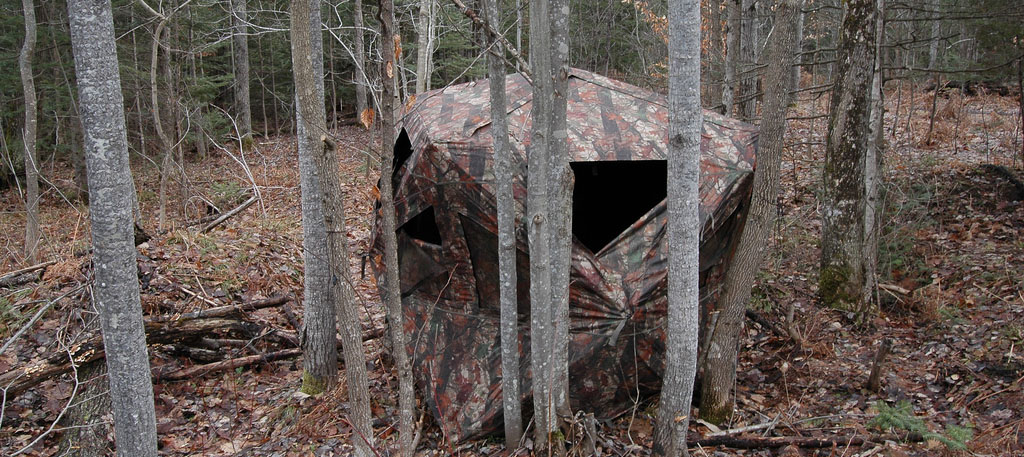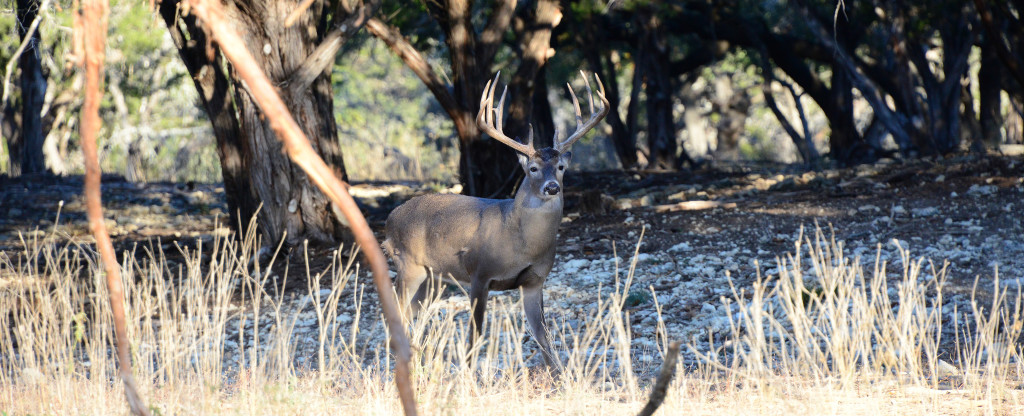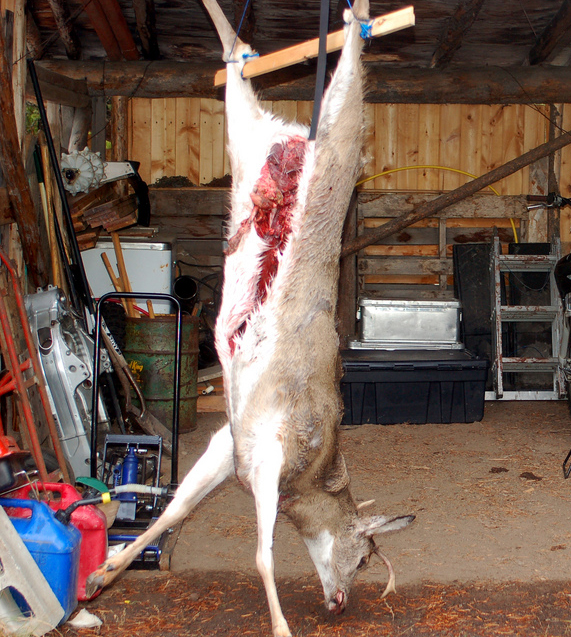The overwhelming majority of rifles sold these days are AR 15's. The majority of these rifles are chambered for .223. The strengths of the .223 cartridge are many, including almost no recoil, cheap ammo and lightweight rifles. Many people want to go deer hunting with a .223, a round typically scoffed at when mentioned as a deer cartridge. This can bring mixed feelings because bullet technology is opening doors and allowing for smaller cartridges to be used for bigger and tougher game.
Bullet construction is now at the forefront of cartridge design. Many of the magnum class cartridges wouldn’t be around if tougher bullets weren’t around because traditional cup and core bullets don’t kill tough game well at high velocity. These bullets explode and don’t penetrate well as they lose their mass.
This is perfect if you’re hunting small bodied varmints, but is disastrous on large bodied or medium game that need penetration to kill. The .223 uses high velocity to kill and the new space age bullets are needed for reliable expansion. This is one of the main caveats for using the .223 for deer hunting.
How a Bullet Kills

Bullets kill in two ways. First they poke holes in tissue to let blood out. Without blood no mammal can live. Most animals don’t asphyxiate from the blood loss like many people think. There’s plenty of oxygen in the blood to allow for an animal to run sometimes hundreds of yards. Most animals die from a sudden loss of blood pressure and the blood stops moving around in the animal.
The second way an animal dies is from trauma to internal organs and shock from the energy imparted. This is called hydrostatic shock. The trauma and shock is due to the energy dump of the bullet suddenly slowing down inside the animal. This energy dump can rip apart organs such as the lungs and the heart and cause further internal bleeding to lower blood pressure and make killing faster. The rupture can also cause instant death by severing the spine or brain.
This is important because the .223 cartridge can lack penetration and carries little or no hydrostatic shock. This is a problem when deer hunting with the .223 because deer need to be put down quickly or leave a serious blood trail so you can recover your animal.
.223 For Deer Hunting
The .223 caliber cartridge is a viable, some would even say excellent, cartridge for a number of reasons but with a few caveats:
- REQUIRED to use a premium bullet
- MUST choose your shots carefully
- HAVE to shoot at close range
Using a premium bullet for deer hunting with the .223 is especially important because with so little weight behind a .22 caliber bullet you need to conserve all the momentum you can. The .223 bullet was originally designed to fragment and tumble end over end after hitting the target. This was deemed “high velocity projectile deformation and fragmentation” by the military and essentially turns the bullet into shrapnel. This is fine with coyotes, terrorists, or small game but won’t reliably drop medium game like most deer.
Using a premium bullet to conserve mass and penetrate completely is imperative. Varmint bullets have no place on big game, even head or neck shots. FMJ or non-expanding ammunition is forbid by law in most if not all states with hunting seasons. Monolithic, bonded or otherwise premium bullets are what make the .223 a viable deer cartridge.
Even with the advancements in bullet design and weight retention technology you have to keep your shots on game limited to broadside or slightly quartering away, no exceptions. Bullet blow-up, deflection off heavy bones and little if any penetration accompanies these shots that could be fine with a more conventional round.
Finally, you have to be at relatively close ranges for the .223 round to work for deer hunting. The .223 relies on velocity and the light weight bullet sheds velocity quickly. Think of the.223 as a pointy .30-30 and you’ll be fine. Limit your shots to 150 yards and get as close as possible to your deer before shooting.
What .223 Rifle to Use
Some .223 rifles just aren’t well suited for hunting. The .223 cartridge relies entirely on velocity and some rifles handicap this. Short barreled carbines are handy in and out of the truck, around the farm and are the best for long stalks for deer. The problem is the shorter barrels handicap the round and make it almost unethical to hunt with.
The worst offender of these are the AR 15 carbines with short barrels and the new breed of AR 15 pistols chambered in .223. The minimum barrel length for hunting deer should be around 16-18 inches and preferably 20-22 inches for the .223 cartridge. Even then, this is still only a 150-yard cartridge. Plenty of gun for most deer hunting situations but the super short 12 inch barreled guns have no place in the woods regardless of the game pursued.
Once velocity falls below 2300fps or so there is no reliable expansion, and the low mass of the .223 bullet can’t be called upon to have enough momentum to penetrate deep enough to make a clean kill. An example of an ideal rifle for .223 deer hunting would be the Ruger American Compact. It’s short, light, inexpensive and comes with a long enough barrel to allow for sufficient velocity and a reliable kill.
.223 Bullet Recommendations
Federal Fusion
The Federal Fusion is a traditional cup and core bullet with an additional bonding process that helps it hold together under high speed and stress. It is perfect for deer hunting with a .223 and in fact the company has a line of hunting ammo with their fusion bullet called the “MSR” line tailored to AR 15s. This is a great bullet that holds up and expands violently without the cost of all copper or super premium bullets.
Nosler Partition
What is there left to say about the Nosler partition? The original premium bullet created for elk hunting in the temperate rain forests of Washington, the Partition was a step into the future. The name comes from a copper alloy bulkhead that separates two lead cores. The front end of the bullet expands quickly and violently, often fragmenting. The rear end of the bullet tumbles through the animal retaining 65-70% of the weight to ensure complete pass through. When in doubt, go for partitions.
Barnes TTSX
A monolithic all copper bullet from Barnes, a Remington brand, this is a great bullet. The .223 bullets for hunting are long for caliber and have great ballistic coefficients (especially the tipped variety) that holds velocity well. The main selling point of this bullet is its ability to violently expand while retaining 99% of its weight. The petals that spread out rip through the animal and an exit is almost always guaranteed. The other TTSX bullets from Barnes are too stout for deer but as long as you keep the velocity high on the .223 bullets there should be zero issue.
Nosler E-Tip
A new and fantastic offering for reloaders who live in lead free zones, the Nosler E-Tip bullet is an all copper alloy bullet. Its main selling point is its ability to virtually retain its weight but expand. It is a lot like a slightly softer version of the TSX family of bullets from Barnes. These bullets are great for hunting deer especially because they’re long for caliber, but still slightly lighter weight than lead bullets. This means a high ballistic coefficient and high velocity to force expansion on thin skinned game like deer. They are perfect for deer hunting with a .223.
Who Should Use the .223 for Deer Hunting
The .223 for deer hunting is really an expert’s gun. While it’s tempting to hand it off to a youngster or small framed woman because the rifles are lightweight and the recoil is almost non-existent it can be a very, very bad idea. Shot placement must be just right and new shooters will rarely have the target discipline and marksmanship to really wait for a good shot and take it.
I would caution new AR 15 owners who are on their first rifle and want to start hunting. Be very practiced and try to get experience hunting with a .243 or .308 before you start stalking or ambushing large bodied deer with the little .223. The .223 is a very unforgiving cartridge on medium game and technique is everything.
The .223 is a great round for what it was intended for, it can be pressed into service as a medium game round if you are diligent in how you use it. Experts who choose to use their AR 15, varmint rifle, or other lightweight gun will be served well by the light recoil, cheap ammo, and abundance of loads available. It is very easy to shoot but you have to keep your shots close, clear and use the right ammo. Deer hunting with a .223 is made possible by advanced bullets and advanced shooters.





what happens when the round hits foliage? would they start spinning?
There needs to be some consideration of “deer size” in articles on best calibers, ammo, bullets, for deer hunting. There is a huge range of size for deer in the US. In the coastal areas of NC/SC 70-130lb deer are the norm. Small fast light bullets are very effective on small deer. A 200+lb white tail in Pennsylvania is likely a different story. The shock and fragmentation of .223 in the vitals of a smaller deer are likely more effective than a non fragmenting slower .30 caliber in the same area.
Ethics and all aside people often pose a question: “If the deer is moving away and I shoot it in the butt will the bullet pass all the way to vitals and kill the deer?”……This is not a good shot for .223. Even for a small deer. If you’re a good rifleman with a AR at 75M or less in a open area and a quick follow up shot is doable after knocking the deer down you might be successful.
My father hunted deer for years with a 22-250 and 60 grain ballistic tips. He’d put it on the neck and the deer always dropped in their tracks. After a mid body shot on a moving deer failed to put the deer down quickly he went back to his .270.
Generally I agree with this article; except for the range limitations. I long thought that a shot over 200 yards was a bit much for the .222 or .223, then I took a 300 yard shot with the .222 and dropped the animal in it’s tracks. It was headed up a hill and I took it high behind the shoulder. The bullet penetrated downward through the lungs and out. This season I took my 70 pound 10-year old daughter on her first youth hunt with a Savage Model 11 .223. Again I kept the distance under 200 yards, but we were having a hard time getting a clean shot at that distance. She kept telling me she could make the 300 yard shot, but I ignored her. Finally, after 4 days of hunting, we saw a couple of deer in a field about 250 yards away. She asked if she could take a shot and I said go ahead. The deer headed up a hill and she took the shot. My guess was off. We were more like 300+ yards away when I gave my O.K. and the actual shot was laser measured at 393 yards. Dropped the small buck, he got up and stumbled down the hill and laid down. When we gutted him I found the bullet had hit the back of the shoulder, tore it up (bone splinters everywhere) and went through between the ribs and into the lung. It was dead right there, it just took a minute to figure it out. I still don’t like taking shots with any gun much over 200 yards, but I will never again say the .223 can’t do it at longer range. The bullet was a Winchester soft point 64 grain. Look, I’ve seen bad shots with a .30-06 where a deer went a half mile or more before laying down and no blood trail we could find. Bigger isn’t better if you hit a bad shot!